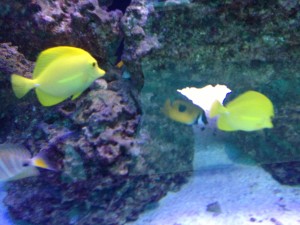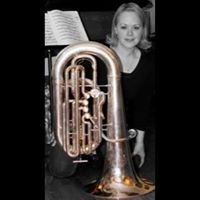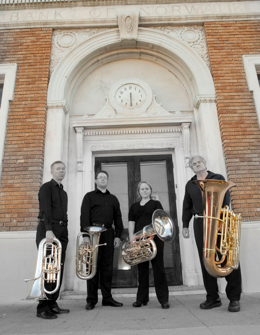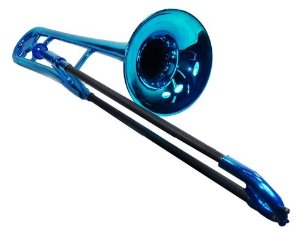 Beth Mitchell is an active Los Angeles freelancer, having worked with the Los Angeles Philharmonic, and Orange County Philharmonic Societies, the Los Angeles Zipper Orchestra, and many other arts groups giving concerts, masterclasses and numerous solo and chamber recitals around southern California. davidbrub eck.com is proud to present Beth Mitchell in the third installment of “The Fourth Valve” tm, and as special guest performer on the Stereogram Recital at the 2014 International Tuba and Euphonium Conference at Indiana University. Beth will perform Stereograms in recital along side their composer-bass trombonist David Brubeck, and guests Patrick Nyren on euphonium and Kelly Thomas on Tuba on Saturday, 24 May 2014 from 1:45-2:45 pm in Sweeny Hall.
Beth Mitchell is an active Los Angeles freelancer, having worked with the Los Angeles Philharmonic, and Orange County Philharmonic Societies, the Los Angeles Zipper Orchestra, and many other arts groups giving concerts, masterclasses and numerous solo and chamber recitals around southern California. davidbrub eck.com is proud to present Beth Mitchell in the third installment of “The Fourth Valve” tm, and as special guest performer on the Stereogram Recital at the 2014 International Tuba and Euphonium Conference at Indiana University. Beth will perform Stereograms in recital along side their composer-bass trombonist David Brubeck, and guests Patrick Nyren on euphonium and Kelly Thomas on Tuba on Saturday, 24 May 2014 from 1:45-2:45 pm in Sweeny Hall.
1. How do you conceive of, describe or imagine the ideal tuba sound? (Bb, C, Eb, F.)
As a free-lance musician in L.A. my ideal tuba sound changes with the kind of gig I’m playing. What I personally like best is a big full, rich orchestral tuba sound on Cc tuba, but that isn’t always ideal if I am playing chamber music, a recital, or soloing with an orchestra.
Different sizes and keys of tuba- Bb, C, F, and Eb are like tools in a mechanics garage. You use the appropriate size/keyed tuba for the music you are playing. You wouldn’t/SHOULDN’T use a wrench to hammer in a nail, neither would I use my little solo F tuba to play Prokofiev Symph. No 5
2. How do you achieve more musical expression?
More musical expression can be achieved in so many ways. First step is to observe anything printed in the music. Articulation and dynamics for starters, speeding up, slowing down tempos, then you can play with attacks on individual notes, shaping lines and phrases, etc…
One of my favorite euphoniumists once said, “when your memorization ends, your music can begin” meaning that once you internalize a piece you will start to understand its nuances, phrasing, and a whole new level of music is opened up to the performer.
 3. Name two types of inspirations:
3. Name two types of inspirations:
Musical: THE MOST influential musical inspiration for me is my brother, bass trombonist Ben Chouinard. I was 14 when he encouraged me to switch from clarinet to tuba. The first day I brought a tuba home he sat me in front of our record player and had me listen to a duet album of Michael Lind and Christian Lindberg. “Listen to Michael,” he said “THAT is what you are supposed to sound like.” In the early years he taught me to breathe, play in tune, how to support an orchestra, and how to fit into the sound of my section. He got me on a diet of Roger Bobo, Arnold Jacobs, the Chicago Symphony Orchestra, the Empire Brass, Canadian Brass, and any good CD we could get our hands on. He is my greatest musical inspiration to this day.
My greatest non-musical inspiration is my mom. She is an amazing professional photographer, incredibly artistic, a generous person and dedicated Christian. She models and strives to be the kind of woman I would like to be.
4. What was your typical warm-up routine like as an undergrad?
As an undergrad David Fedderly turned me onto what I call the ‘Arnold Jacobs 20 minute warmup’. It is found in the back of the Hal Leonard Advanced Band Method book for tuba (pages 50-58, WITH optional articulations). It covers the beautiful sound exercises, scales in all keys, tonguing, slurring through several 8ves, gymnastic rhythmical exercises, articulations, and arpeggios. I’m sure I forgot something…
I know we should switch things up, but it warms up my whole face and it covers almost every aspect of playing I might encounter in any situation. To this day, it is my go-to warmup if I have a long day of playing or only a limited if time on the horn.
5. What one sentence, or so, comes to mind when you think of:
Roger Bobo– ONE SENTENCE? Roger is an INCREDIBLE master tuba player, teacher, and mentor; he is a generous individual, and one of my earliest inspirations who continues to inspire me daily. I am so thankful that I have the opportunity to work with him as often as he comes into LA and will continue to pester him as long as he allows me to.
Patrick Sheridan– Patrick has showed me that what is seemingly impossible on tuba is NOT, and can be done with pizazz and flare; he is a fine teacher and has the most spectacular wardrobe I have ever seen on any tuba player
Jim Self– Jim is an inspiring tuba player and mentor; he has challenged and pushed me as a tuba player in new directions and taught me so many things about life, music, and tuba.
Doug Tornquist– Doug is an amazing soloist and studio player; I’ve had the privilege of sitting next to him on occasion in sessions, and his playing/reading is beautiful and flawless.
John van Houten– John is a great tuba player, good friend, and mentor, my go-to guy when I need an opinion on a new piece, or to kick my butt on any aspect of playing- especially loud low playing.
 6. How do you view the role of the tuba in a tuba quartet? What are the challenges? The delights?
6. How do you view the role of the tuba in a tuba quartet? What are the challenges? The delights?
The roll of tuba in tuba quartet varies with the part one is playing.
In a tuba quartet you need to know when to play out and when to get out of the way. As a dark conical ensemble, it is difficult for the average ear to pick out and distinguish the important parts, so it is the quartet’s responsibility to make that very obvious. Extremes in dynamics and articulations can be helpful so your ensemble doesn’t all mush together.
1st tuba/3rd chair is often a soloist, or on countermelody with Euph. It is a chair with many hats- you must blend harmonies and get used to not playing the root, but playing in tune within a chord.
I call the 2nd tuba/4th chair the power chair. In this seat you are the tonal foundation and the rhythm section. Whether or not your group stays together tonally and rhythmically many times is up to you. Your pitch must be perfect at all times.
The amount of literature written for tuba/euphonium quartet is staggering considering how long this ensemble has been around. I attribute the enthusiasm for this particular ensemble to the amiable personalities usually found among tuba and euphonium players, their love for community, and beer.
7. When do you prefer cimbasso, and why?
My favorite place for cimbasso is in the movie studios. In the right hands, no instrument can be more sinister, scary, evil, and intimidating than a cimbasso.
8. What is the best tuba playing you have ever heard?
Recently? Øystein Baadsvik. Simply amazing.
9. What is the best tuba playing you have ever done?
Playing with great symphony orchestras is my personal highlight. I LOVE orchestral playing- the colours, the passionate music making, mixing my sound with a good section, exploring the genius of a great composer. As get older, play longer, experience more of life, my perspective changes. I become a stronger and better musician. I think my best days are coming, and I can’t wait to see what they will be.
c. 2014 David William Brubeck All Rights Reserved. davidbrubeck.com
Interested in more “The Fourth Valve” tm Interviews?
Don Harry
John Stevens
Jim Self
John Van Houten
Demondrae Thurman
Deanna Swoboda
R. Winston Morris
Beth Wiese
Aaron Tindall
Marty Erickson
Beth Mitchell
Chitate Kagawa
Aaron McCalla
Images courtesy of Beth Mitchell

